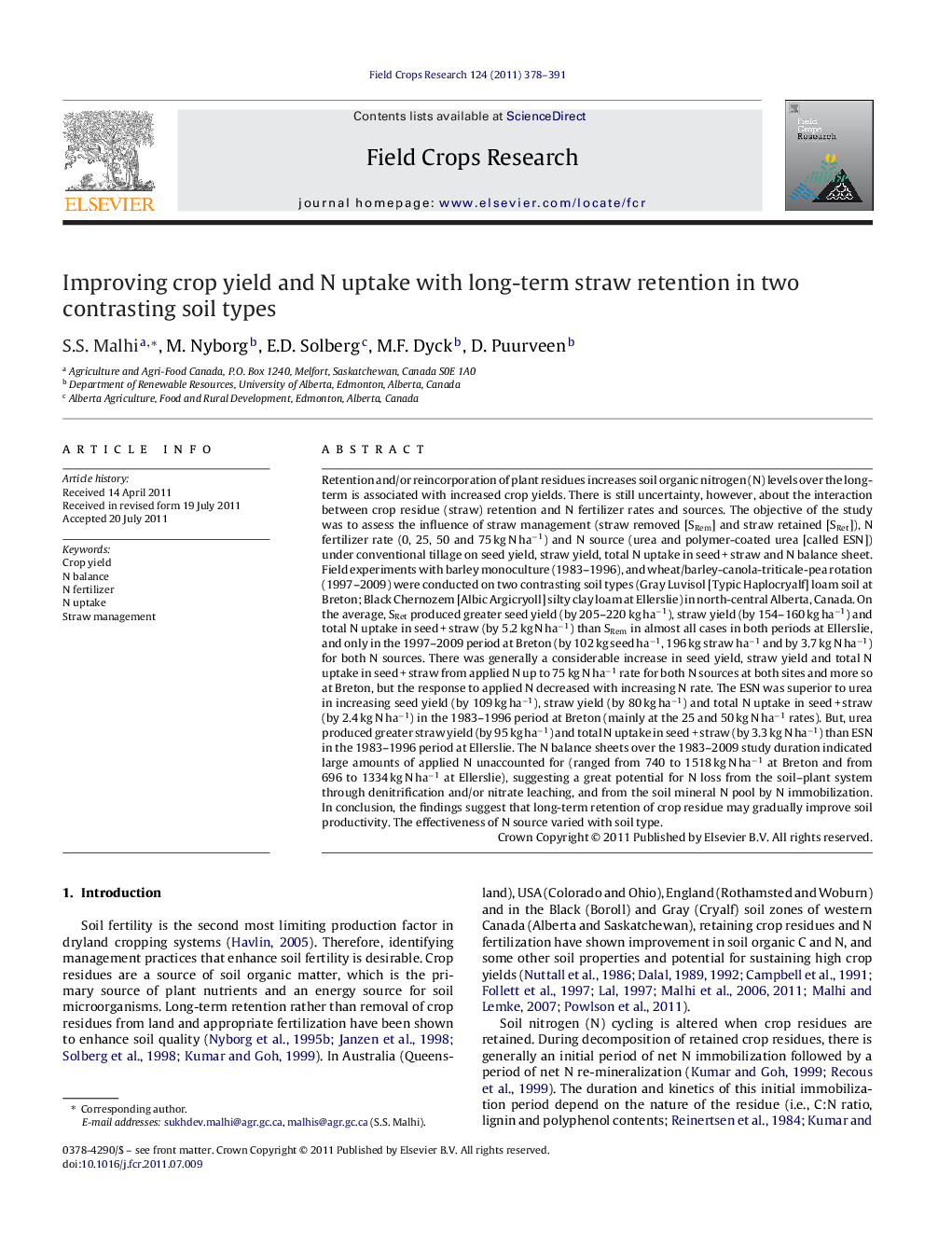| کد مقاله | کد نشریه | سال انتشار | مقاله انگلیسی | نسخه تمام متن |
|---|---|---|---|---|
| 4510606 | 1321865 | 2011 | 14 صفحه PDF | دانلود رایگان |

Retention and/or reincorporation of plant residues increases soil organic nitrogen (N) levels over the long-term is associated with increased crop yields. There is still uncertainty, however, about the interaction between crop residue (straw) retention and N fertilizer rates and sources. The objective of the study was to assess the influence of straw management (straw removed [SRem] and straw retained [SRet]), N fertilizer rate (0, 25, 50 and 75 kg N ha−1) and N source (urea and polymer-coated urea [called ESN]) under conventional tillage on seed yield, straw yield, total N uptake in seed + straw and N balance sheet. Field experiments with barley monoculture (1983–1996), and wheat/barley-canola-triticale-pea rotation (1997–2009) were conducted on two contrasting soil types (Gray Luvisol [Typic Haplocryalf] loam soil at Breton; Black Chernozem [Albic Argicryoll] silty clay loam at Ellerslie) in north-central Alberta, Canada. On the average, SRet produced greater seed yield (by 205–220 kg ha−1), straw yield (by 154–160 kg ha−1) and total N uptake in seed + straw (by 5.2 kg N ha−1) than SRem in almost all cases in both periods at Ellerslie, and only in the 1997–2009 period at Breton (by 102 kg seed ha−1, 196 kg straw ha−1 and by 3.7 kg N ha−1) for both N sources. There was generally a considerable increase in seed yield, straw yield and total N uptake in seed + straw from applied N up to 75 kg N ha−1 rate for both N sources at both sites and more so at Breton, but the response to applied N decreased with increasing N rate. The ESN was superior to urea in increasing seed yield (by 109 kg ha−1), straw yield (by 80 kg ha−1) and total N uptake in seed + straw (by 2.4 kg N ha−1) in the 1983–1996 period at Breton (mainly at the 25 and 50 kg N ha−1 rates). But, urea produced greater straw yield (by 95 kg ha−1) and total N uptake in seed + straw (by 3.3 kg N ha−1) than ESN in the 1983–1996 period at Ellerslie. The N balance sheets over the 1983–2009 study duration indicated large amounts of applied N unaccounted for (ranged from 740 to 1518 kg N ha−1 at Breton and from 696 to 1334 kg N ha−1 at Ellerslie), suggesting a great potential for N loss from the soil–plant system through denitrification and/or nitrate leaching, and from the soil mineral N pool by N immobilization. In conclusion, the findings suggest that long-term retention of crop residue may gradually improve soil productivity. The effectiveness of N source varied with soil type.
► We examined long-term effects of straw and N fertilizer on crop yield, N uptake and N balance.
► Crop yield and N uptake were greater with straw retention compared to when straw was removed.
► There was a considerable response to applied N.
► Polymer-coated urea (PCU) was more effective than urea in 1983–1996, while urea was superior to PCU in 1997–2009.
► There were large amounts of N unaccounted for from the soil–plant system.
Journal: Field Crops Research - Volume 124, Issue 3, 20 December 2011, Pages 378–391